It will be interesting to see how the sport of cricket will pan out in the coming months. At the time of writing we are still awaiting final details from the ECB of when and how clubs will be able to implement cricket matches at their facilities.
It may be too little, too late for some cricket clubs. The schools cricket calendar may have already been decimated at many school grounds, while grassroot cricket clubs are still waiting for the go ahead and no doubt will be restricted on the amount of games they can play at both senior and junior levels.
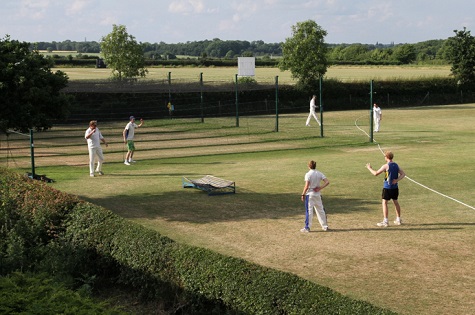
As we all know this lack of cricket activity will have a profound effect on the club’s finances - which in turn may lead to clubs not being able to afford to undertake some essential maintenance works.
During the current Covid-19 lockdown The England and Wales Cricket Board (ECB) launched their ‘Together Through This Test’, a nationwide campaign shining a light on the work undertaken by the game in response to COVID-19 and highlighting the resources available to the public.
Cricket staff, volunteers and players across the country - from both the professional and the recreational game - have already taken part in over 200 initiatives during lockdown.
Projects include long-distance charity runs, delivering food to the vulnerable and a dedicated phone support service for those left isolated by coronavirus.
The ECB also have published a list of guidelines that clubs should adhere to during this pandemic.
On 31 March, the ECB announced an interim funding package of £61million for the recreational and first-class game. This will provide immediate cash assistance to the game.
Just over £20million of that interim funding package will go specifically to supporting the recreational game.
The ECB continue to talk regularly to the County Cricket Boards (CCBs), leagues and clubs across the country to ensure they are able to offer the support that is required.
In addition, cricket clubs and leagues are now able to apply to three new funding schemes specifically designed to help see them through the ongoing coronavirus pandemic.
Click here for comprehensive information on the ECB Emergency Loan Scheme, the Return To Cricket Grant Scheme and the ECB League Emergency Loan Scheme.
There are a range of other financial support packages that are available to recreational sport and the ECB strongly encourage local clubs and leagues to investigate their eligibility for these, which are available immediately subject to meeting the respective criteria.
I personally know it’s going to be a difficult season for all cricket groundsmen, not knowing the full remit of what can and cannot be achieved. I am hearing on the grapevine that some clubs are going to have save money somewhere - and will it be the groundsman who has to go without?
By this I mean that some clubs are talking about saving money by not undertaking any end of season renovation work on their square and outfields - especially if they have had very little, or no play on their pitches.
I recently called up a number of groundsmen to ask them their thoughts on how they have managed to cope to date:
Karl McDermott, Lord’s
"It’s been a strange ‘season’ so far. The pandemic has meant that I have been working on my own for the majority of the time which has been lonely but also given me a chance to get to know Lord’s and the ground dynamics a bit better as I’ve been cutting every blade of grass myself.
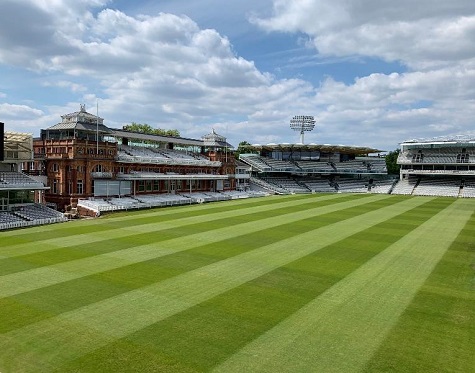
It has also been unusually dry. I can count the number of days rain we have had since lockdown on one hand. Growing conditions have been great but there have been times where I felt like I have just been a grass cutter and not a cricket groundsman - it’s been eat, sleep, cut, repeat!
I know it has been the same for many club groundstaff around the country. From the wettest of winters to now the driest of summers. Both have created issues and it’s sometimes funny how things work out when we all thought the squares and grounds would never dry out - now we can’t get enough water on!
I have been in contact with many ‘groundies’ all over the country and I am always pleased to see the wonderful photos across social media of cricket grounds and squares looking so well. There is a nationwide battle with poa and believe me when I say I also have that problem at Lord’s. It’s a curse!
Fingers crossed there will be cricket soon, and then our planning goes into pitch preparation and how we can get the most out of what’s left in the season.
I know it’s early, but I also have one eye on the end of season renovations. This is the most important time for a cricket square and I can’t stress enough how crucial it is. Even if we have no cricket you should still renovate your square. There will be a build-up of thatch and debris on the surface from your mowing - you would be surprised how many clippings don’t end up in the grass box. I know finances are currently tight in clubs but speak to your committee now and plan well in advance.
It is easy to look out at the ground and see how pretty it is, and the danger is that you feel it’s a waste to rip it up. It’s not, and you will reap the benefits of a better surface next year. So, my advice is to plan now and renovate whenever your season comes to a close.
The earlier you get the works done the better."
Vic Domain, Durham County Cricket Club
“Living on site made working during the Coronavirus outbreak quite easy for me personally. Being behind locked gates, with only two other members of staff, made social distancing easy.
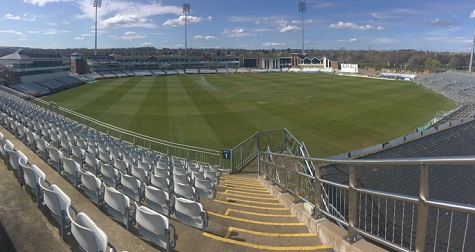
My deputy Mark and myself adopted what we called a maintenance programme of simply cutting and watering. Feeding was kept to a minimum to hold back excessive growth.
Renovations this season could be seen by certain clubs as an area to reduce spending, but in my opinion it would be a mistake which could have repercussions in coming years. With pitches not being thinned out and prepared for games, there could be a lot of organic decay in the base which will require severe scarification, otherwise we could get low and slow pitches next season.
As there will be less damage to the square from playing games, it could be possible to use less seed and loam, which will help the treasurers."
Keith Exton, contractor
"As a sports turf contractor this pandemic has hit my business hard. I have only done a couple of small jobs in the last 8 weeks. It was my choice to self-isolate for the first month, but after that the phone just stopped ringing.
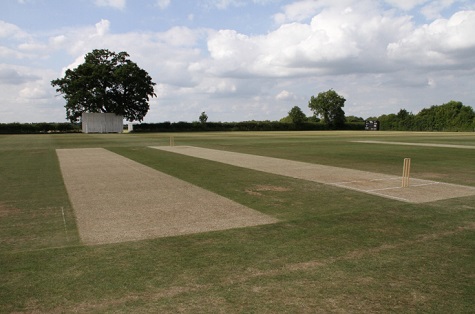
Supplies were taking a long time to be delivered, and other contractors were working for what appeared to be a poor rate of return, especially on the Pitch Improvement Programme from the F.A grants scheme.
I have quoted for a lot of work later in the year and hope I get some of the contracts, but who knows? I can survive for another couple of months with little or nothing coming in, but after that it will be difficult bridging the gap before work hopefully picks up. I have not been eligible for one reason or another for government schemes/grants - but healthy enough to carry on when and if we get back to the new normal.
Although not actively involved in looking after a cricket venue on a day to day basis, the evidence I am seeing on my travels is that clubs are tending to leave a longer sward on their squares because of no required cricket preparation and also because of this exceptional dry period we have had through March, April and May.
I have seen squares that have very little irrigation, no feed, and are cracking badly, to the other extreme squares have had a lot of fertiliser applied and backed up with plenty of irrigation, giving a beautiful colour and a very lush sward.

The beauty of this industry is no two venues are the same, but if only a couple of month’s worth of cricket is played there will be many pitches that are not played on.
Pitch preparation by its own nature of disciplines, allows a for a good clean out, mowing lower, scarifying, brushing, giving a clean sward, a mini renovation in its own right.
If pitches are not used, even with regular verti cutting / scarifying, and with the additional length of sward clubs are adopting, these practices never get as much debris out as when it is cut short and given a proper hard scarifying after the season has finished.
Pitches that have be played on, and often over played, with the rolling, will have at least 40% of grass cover lost, and not just at the ends.
So, which ever situation this cricket season ends up in, I personally would advocate a full renovation should be undertaken.
Add a couple more points to the equation.
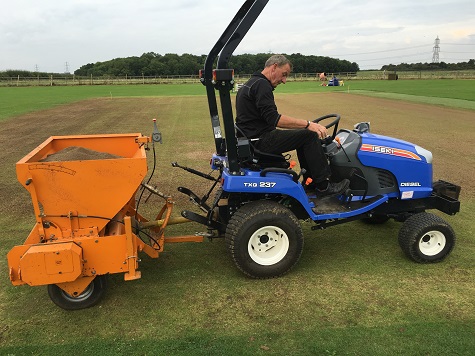
Because of last Autumn/ winter being so wet and warm, POA Annua is rife all over the country, also a lot of last years renovations had wash off before new seed had chance to germinate, leaving a thin sward of DPRG which if additional over seed in the spring might have failed because totally opposite conditions prevailed, then the lonely DPRG will have gone clumpy and will go woody, left to its own devices with out work this Autumn it will end up so strong, even with good pitch preparation next season, you will end up with an uneven density of sward, which will invariably give you an uneven bounce, and seam movement.
On the plus side, with out so much heavy rolling taking place, grass roots should have gone deeper into the profile, this in turn should give a better recovery after a good scarification has taken place in the Autumn, so in may well be a case of not using quite so much seed, and as long as your scarifying machine leaves deep enough grooves for the seed to get a good soil seed contact, then as long as your levels are good and don’t need to be adjusted, then a reduction of loam could be implemented as well.

Fertiliser added to keep things ticking over dependant on your soil sample results, or in most cases what your experience from visuals tells you.
I all so think deep spiking should take place at the normal time after renovations, even if no cricket is played.
As we are aware that grass plants have die back of their rooting systems over a growing cycle, this is exaggerated by heavy rolling, but even in normal circumstances these dead roots need to be aided in breaking them down, or fibre builds up in the soil profile, and it does not matter what weight your roller is, you can’t roll fibre in high % rates contained in the profile to give the hard pitches we all strive for.
Air, water, gaseous exchange, allowing microbes to work to break down this fibre are given a head start by deep spiking, as well as the more obvious of giving new roots an easier passage through what is nearly always a near block of concrete after a seasons play.
Remember a deep rooting system not only binds the soil together, it alters the rolling regime, as transpiration is taking place from a greater depth.
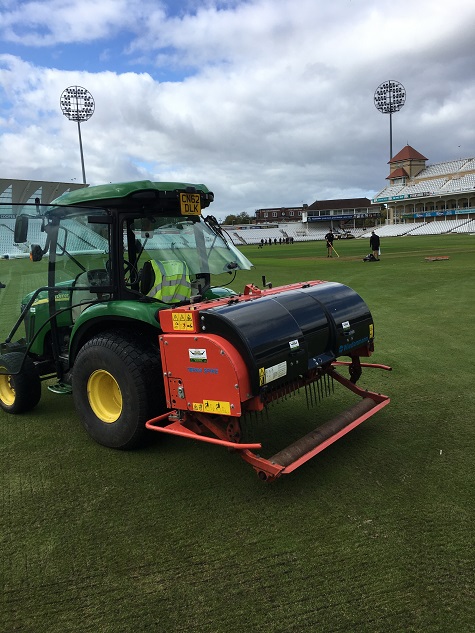
You might be interested to know that from experience gained last year whist deep spiking a number of first class grounds in January, because it had been deemed too wet to get on them before then, although still wet on the surface, once the 10mm tines were driven through the profile to achieve a depth of 175/200mm, it was still hard even after all the rain we had had.
Either a dig or cores taken quite clearly showed that the top 50mm were like Plasticine but under that it was as dry as a digestive biscuit.
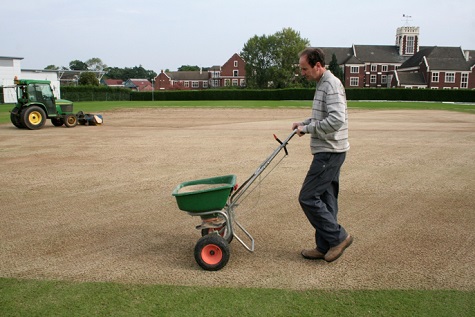
So if no play, thatch levels will have built up to an unacceptable levels for cricket, and will be rife for disease out breaks especially if we have another mild winter.
If it comes to pass that the ECB state in July no recreation cricket will be played this season, I would be very tempted to mow the square down to 8mm, give it a good scarifying, feed, water up.
Then repeat that operation in the beginning of September, having mown down to 6mm first.
By doing this you may well get away with what we now all term a full autumn renovation.
Its all about that thatch and fibrous control but keeping the plant healthy.
Some play. Same as above but played on pitches devoid of grass and will require renovation.
Outfields: Possibly the same problems if minimal management has taken place.
On the Question of Budgets - Many clubs have had a £10,000.00 grant payment from their local authority, via sport England.
I as a sports turf contractor have had many new enquiries from clubs that in the past just could not afford a full renovation, but this wind fall has given them a chance to have more work undertaken than they normally would.
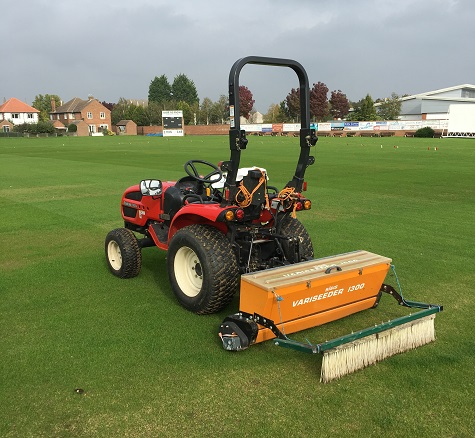
So in Lincolnshire/ Leicestershire it is not all doom and gloom, and I presume these grants are nationwide so many clubs are actually better off than what would have been generated into the club over a normal season of relying on subs/match tax.
Now will show which clubs think that the bit in the middle is of most relevance, or that they need a new refurb in the clubhouse.
James Mead, grounds manager, Rugby School
“Here at Rugby School we are anticipating a return of 1st June for the prep school and September for the senior school. We have tackled the challenge, to keep the square cut at 10 mm with a constant grooming programme with the ATT ultra-groomer.
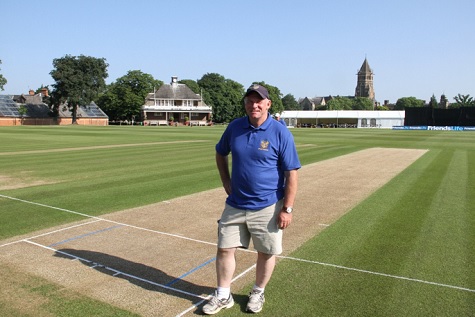
This eliminates any lateral or unwanted growth. We also made the decision to use a slow release 4-5-month granular fertilizer. Complemented with liquid feeds of sea action seaweed and green solutions plus wetting agents.
Seeding with a tractor mounted Blec dual dimple roller seeder with MM50 done early, maximising healthy vigorous growth. With use of the rain train, we will endeavour to aerate. What we want to achieve by September is a square ready for play but is also prepared for 2021.Food for thought? Grounds may also use this unique time. For transformation work that would usually be impossible due to time restraints. Use of the koro, if thatch has been a problem, maybe even in conjunction with a rotavator, to finally clear up any layering problems. Also, look at water supplies to the square, can this bettered with separate water tanks with submersible pumps, fed from the pavilion? Let us turn this crazy summer into opportunities to better our grounds.”
All in all, the general advice outlined above is that cricket clubs should really be looking to do some level of renovation to the square and outfield to ensure they will be fit for play next year.
The objectives of end of season renovations are:
- To repair worn areas.
- Prevent a build up of thatch layers (scarification).
- Restore surface levels (top dressing).
- Alleviate compaction (aeration).
- Re-establish sward densities (overseeding).
- Application of Pre-seeding/autumn fertilisers to promote sward establishment.
Let all hope after all the hard work that’s being done we are finally rewarded with some cricket being played at all levels before the end of the season.